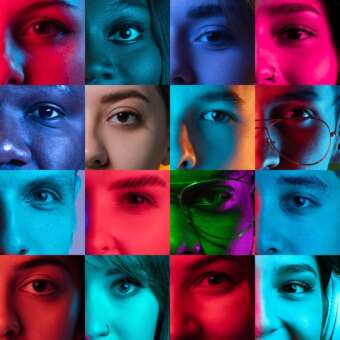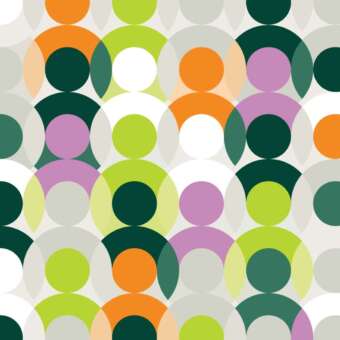How Seamless Consumers Will Shape the Future of Shopping
The article appeared at marktforschung.de on January 11, 2023.
According to Judith Barbolini, member of the management board at rheingold institut, shopping will in future be driven more by the desire for personal development and solutions to life problems. Companies urgently need to rethink.
Who hasn't stood at the checkout line, critically analyzing the purchases of the person in front of them in line and getting a picture of their life? Rightly so! Vegetarian frozen curry, protein shot and Riesling awaken completely different fantasies than steak, Korn and Marlboro. Psychologically, every purchase is a process of self-discovery and identification with a group, an idea or a desire.
Products transport values, ideas and thoughts.
But how do we shop in a future reality that offers hardly any social templates and role models with which we can or even want to identify and thus places the totality of possibilities in front of our feet? How will consumers shop in the future when everyone is supposed to be unique and groups and standardized products no longer create identity?
Despite all the crises, the world of shopping is currently developing at a rapid pace, people are adapting new technologies - new psychological needs are emerging.
So it is precisely now that brand managers should design and radically adapt to this new reality, in which consumers operate seamlessly between analog and virtual worlds and become "seamless consumers" in the truest sense of the word.
Seamless consumers primarily want solutions to life problems
Consumers of the future no longer want to buy lipstick, but a personal concept of beauty - 'my most beautiful self'. They no longer want to buy a ticket from a vending machine, but to move seamlessly and effortlessly between means of transport and transportation options. To understand the consequences for brands, it's worth taking a closer look at our social and psychological evolution there.
Our lives have become increasingly individualized, virtualized and dematerialized over the decades.
Shopping 1.0: Meeting needs in the postwar period
When milk was still milk and you didn't have to choose between alpine milk, pasture milk. Oat milk or almond milk, shopping was still easy from a psychological point of view. In the post-war era, the world is analog, linear and manageable. Shopping is primarily about meeting needs. Products are either good or not so good, but in any case they can be touched, tasted and are strongly rooted in the material - the product is the focus.
Shopping 2.0: Self-appreciation
With the loosening of class boundaries and the emergence of consumer worlds, products gain symbolic value. In the 1960s/70s, products increasingly mark status and membership in a socio-demographic milieu. A period of growth begins. Faster, higher, further, more! Advertising shouts: Make something of yourself! Make something of yourself! But by the 1990s, a certain saturation of consumption had already become apparent.
Products are becoming cheaper and cheaper, people more demanding and critical.
Shopping 3.0: Shopper Experience
With the smartphonization of the world, shoppers are becoming omnipotent and ever more demanding. No matter where or when, they have access to every conceivable product or service at the swipe of a finger. This is also changing the relationship to shopping. Emotions, experiences, self-awareness - consumers want to be addressed playfully (gamification) and effortlessly (customer experience) both online and in the store. Shopping 3.0 means full service in satisfying needs and follows a logic of "everything is possible," multichannel options, and permanent entertainment.
The Future: Seamless Reality and Singularities
But our everyday lives are becoming even more virtual, more global, more unpredictable. Apps, solutions and services are becoming more and more important. Thanks to AI and ever greater networking and virtualization, we live in a world in which everything can change at any time.
In many studies, especially on GenZ, we experience that although one has never known freedoms and opportunities, this reality of life is also very unsettling.
The individual has hardly any restrictions that curtail the path of life, but also no role models that could provide direction. Each person may and must develop individually and uniquely (singularities, cf. Reckwitz). From a psychological point of view, this is a great opportunity on the one hand, but also very exhausting on the other. It takes us to our own limits.
Seamless Shopping - Shopping 4.0 as a self-discovery process
Shopping 4.0 of the future is therefore no longer just about fulfilling one's own needs or those inspired by advertising, but shopping will become more than ever a process of self-discovery. Decoupled from natural rhythms and life determinations, seamless consumers of the future will act even more flexibly out of situational needs. At the same time, this fluid reality of life confronts us again and again with the need to permanently reinvent ourselves.
In the future, we will be even more in search of personal self-awareness and self-discovery, orientation and individual development.
AI is the new religion
The questions are continuously being asked: Who am I? What is getting me ahead right now? Even if this is associated with the fear of being screened and manipulated, seamless consumers want more than ever an authority that can understand and advise them individually. Both AI and spirituality show themselves to be higher powers that are connected with the hope of being able to see through and understand more on an anonymous basis and to recognize more connections than humans are able to.
Seamless consumers are not buying a dietary supplement, they are buying the promise of optimized health that is individualized and hyper-personalized to their own body and life needs.
AI in particular, which is currently still fraught with fear, carries the promise of combining medical knowledge and individual assets neutrally and without self-interest in such a way that the best possible personal outcome results.
Brand managers take note!
Seamless consumers need assistance to continually rediscover and reinvent themselves in a seamless and halfless world. They are looking for ways to become his best individual self. This inevitably entails a number of consequences for products and brands. Brands that stand still will be in trouble.
1. SEAMLESS SOLUTIONS instead of products:
We will demand more holistic solutions than just individual products. Individual products and brands thus need a different framework and a new positioning. Brand managers should ask themselves the questions: How can we integrate our products into a larger overall concept? With which other products and brands can we possibly cooperate? For which life issues do our products offer a solution?
2. HYPERPERSONALIZATION instead of target groups:
The Seamless consumer wants to be understood individually and holistically and to discover and learn about products and offers individually. Before we buy a (especially body-related) product in the future, we want to make sure that the product really fits us, our individual state of health, the skin's own microbiome, personal habits and needs, and "understands" us. Skin scans, DNA tests, blood tests, monitoring, tracking, etc. should therefore be more widely used as target-oriented methods for understanding the individual.
To be optimally positioned, brands must focus on the individual and their personal development.
3. DIALOGICAL INTERACTION instead of product communication:
Singularity taken seriously means more direct and dialogic communication and exchange with individuals. Advertising should move in an interactive direction, addressing people directly, inviting personal (and anonymous, AI-driven) testing, and offering holistic solutions that don't just sell a product, but a concept of life in which Seamless Consumers are allowed to feel embedded and understood.
Conclusion
The new thinking in "seamless solutions" requires a major rethink for companies. Brands need to redefine themselves and act differently. The opportunity: the future enables unprecedented proximity to consumers and the development of solutions that fit seamlessly and personally into people's lives. It's worth it.
During the ECR Austria Day 2022, Judith Barbolini gave a keynote on consumers of the future:





